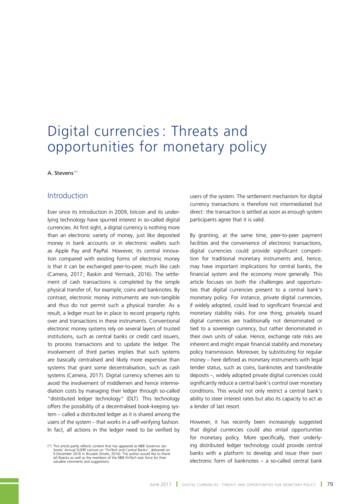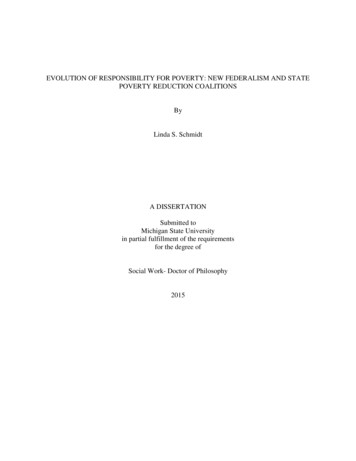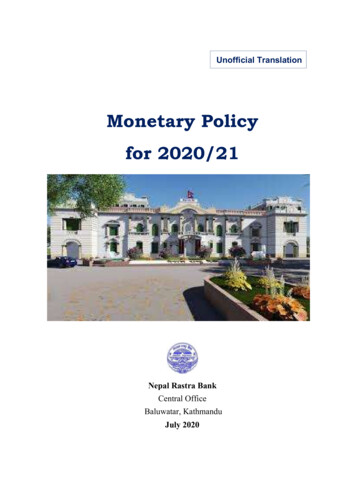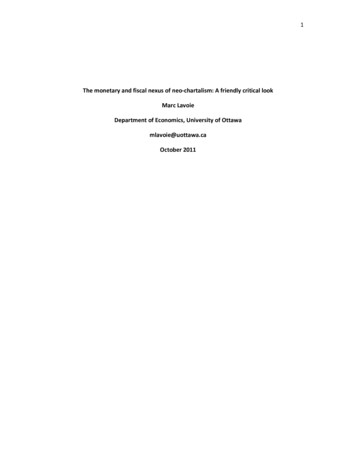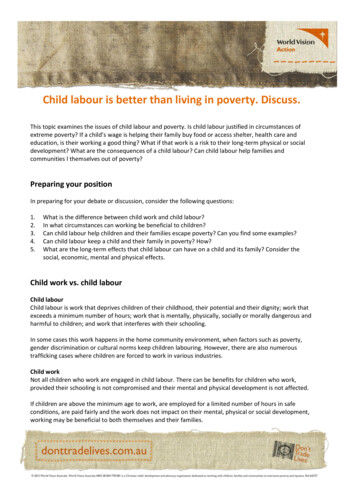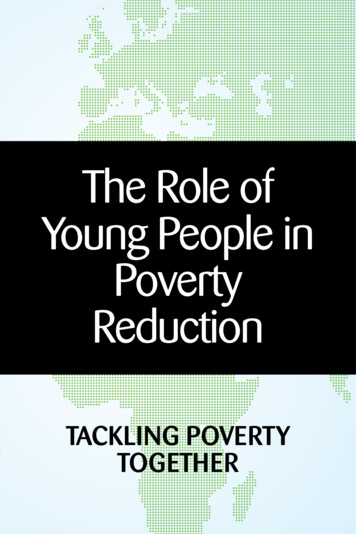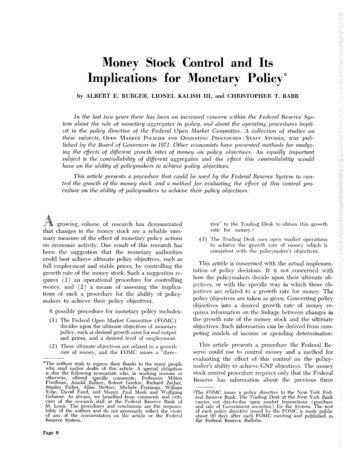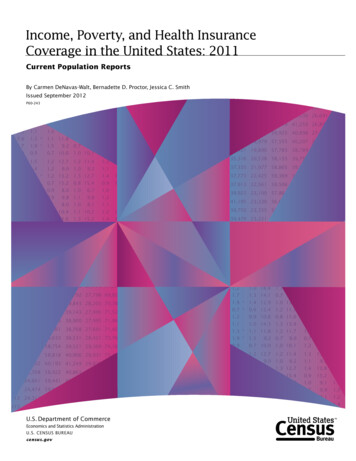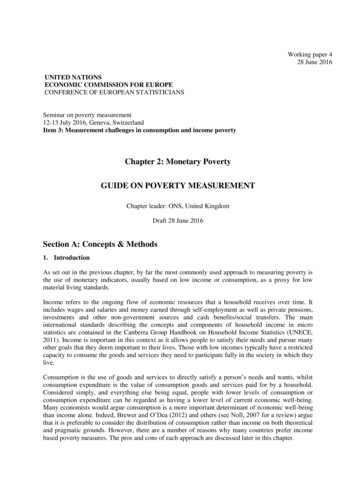
Transcription
Working paper 428 June 2016UNITED NATIONSECONOMIC COMMISSION FOR EUROPECONFERENCE OF EUROPEAN STATISTICIANSSeminar on poverty measurement12-13 July 2016, Geneva, SwitzerlandItem 3: Measurement challenges in consumption and income povertyChapter 2: Monetary PovertyGUIDE ON POVERTY MEASUREMENTChapter leader: ONS, United KingdomDraft 28 June 2016Section A: Concepts & Methods1. IntroductionAs set out in the previous chapter, by far the most commonly used approach to measuring poverty isthe use of monetary indicators, usually based on low income or consumption, as a proxy for lowmaterial living standards.Income refers to the ongoing flow of economic resources that a household receives over time. Itincludes wages and salaries and money earned through self-employment as well as private pensions,investments and other non-government sources and cash benefits/social transfers. The maininternational standards describing the concepts and components of household income in microstatistics are contained in the Canberra Group Handbook on Household Income Statistics (UNECE,2011). Income is important in this context as it allows people to satisfy their needs and pursue manyother goals that they deem important to their lives. Those with low incomes typically have a restrictedcapacity to consume the goods and services they need to participate fully in the society in which theylive.Consumption is the use of goods and services to directly satisfy a person’s needs and wants, whilstconsumption expenditure is the value of consumption goods and services paid for by a household.Considered simply, and everything else being equal, people with lower levels of consumption orconsumption expenditure can be regarded as having a lower level of current economic well-being.Many economists would argue consumption is a more important determinant of economic well-beingthan income alone. Indeed, Brewer and O’Dea (2012) and others (see Noll, 2007 for a review) arguethat it is preferable to consider the distribution of consumption rather than income on both theoreticaland pragmatic grounds. However, there are a number of reasons why many countries prefer incomebased poverty measures. The pros and cons of each approach are discussed later in this chapter.
Working paper 4Page 2Monetary poverty measures can broadly be divided into two types: absolute and relative. Absolutepoverty lines represent the value of a set level of resources necessary to provide a given minimumstandard of well-being. Perhaps the most widely recognised absolute measure is the 1.90 a day (in2011 prices) line for extreme poverty, which has been established by the World Bank. However,different absolute poverty lines are used by many other countries. For example, the United StatesCensus Bureau uses an absolute poverty threshold, which stood at 12,071 a year in 2014 for a singleadult household.By contrast, relative measures utilise poverty lines that are set in relation to the average situationwithin a society. Typically, these lines are based on either mean or median income or expenditure.The rationale for such an approach comes from a definition of poverty that moves beyond absolutedestitution to considering individuals capacity to participate fully in society. An example of such adefinition is that set out by the European Council in 1975, which states that “People are said to beliving in poverty if their income and resources are so inadequate as to preclude them from having astandard of living considered acceptable in the society in which they live.” This definition isoperationalised through the European Commission’s indicator based on the proportion of individualsliving in households with equivalised disposable incomes below 60% of the national median. TheOECD use a similar approach in their statistics, though the main income poverty threshold used is50% of the national median.Despite their usefulness and ubiquity, there are a number of limitations to monetary indicators ofpoverty. Importantly, low household incomes or low levels of consumption do not necessarily imply alow standard of living. A household with a low income may be able to achieve a high standard ofliving through the use of savings or debt (based on an expectation of higher income in the future).Additionally, levels of wealth, which are the third primary component of economic well-being are nottypically taken account of in monetary poverty indicators. Similarly, and depending on the thresholdsused, low levels of consumption may in part reflect individual choices or non-monetary constraints(e.g. elderly people with physical limitations, such as lack of mobility, who may have low levels ofconsumption despite adequate financial resources).More generally, monetary measures based on private household resources do not necessarily reflectaccess to basic services such as education, healthcare, water and infrastructure. Multidimensional andsubjective measures of poverty, which do attempt to take account of such unmet basic needs, aredescribed in subsequent chapters.Such limitations of monetary indicators are often recognised in the way they are described inpublications both by national governments and international organisations. For example, the UKDepartment for Work and Pensions refers to “relative low income” in their published statistics, whilstEurostat report on ”at-risk-of-poverty rates” (DWP, 2015; Eurostat, 2015).2. Unit of observationIn producing data on income or consumption, the normal unit of observation should be the household(or family), for both practical and conceptual reasons. If data are collected through household surveys,it is often impractical and expensive to collect data in detail from all members of the household. Moreimportantly, it is often very difficult or impossible to allocate economic flows to single individualswithin the household or family unit. For example, certain types of income from social protectionpayments may be allocated at the family, rather than the individual level. Similarly, it is challengingto allocate to individuals consumption expenditure that is carried out on behalf of the wholehousehold.The need to measure income at the household level is perhaps best illustrated in the case of familieswith children. The children will typically have few, if any, economic resources of their own and relypredominantly on intra-household transfers from their parents. The measurement of such intrahousehold transfers is, at best, difficult, but by considering the household as the basic statistical unit,the need to do so is removed.The measurement of economic resources at the household (or family) level presents a number ofissues, however. First, it is generally necessary to assume that resources are shared equitably amongst
Working paper 4Page 3all members of the household. In reality, there may be an unequal distribution of resources betweenmen and women or between different generations within the household. The limitations of thisassumption have been widely recognised for some time (Jenkins, 1991) and research has attempted tobetter understand intra-household sharing of resources and its implications for poverty statistics (forexample, Ponthieux, 2013). However, the substantial methodological and data collection challengeshave limited progress and mean that this assumption remains integral to almost all published povertystatistics.A second issue is that in determining whether a given level of economic resources at a household issufficient to meet basic needs or allow participation in society, the number of people living within thehousehold clearly needs to be taken into account. The simplest approach to dealing with this is toconsider household income or consumption per capita. This is the method used for the World Bank’s 1.90/day and 3.10/day poverty lines. However, such an approach fails to account for economies ofscale which can occur within households. For example, a household of three adults is likely to need ahigher income to enjoy the same standard of living as a single person household, but not necessarilythree times the income. Additionally, the per capita approach also assumes that the level of resourcesneeded by, for example, a 40 year old woman is the same as that needed by a 8 year old boy. Toaccount for these points, so-called equalivalisation (or equivalence) scales are often used. These arediscussed later in this chapter.3. Unit of analysisAlthough income and consumption are both normally measured at the household level, this does notmean that households should be the statistical unit used for poverty analysis. Poverty is somethingthat is experienced by individuals, and the aim of policy is to improve the position of those individualcitizens, whether children, working-age or in retirement. As a consequence, poverty statistics shouldbe reported at the individual level, with the indicators used describing, for example, the number ofindividuals in a population living in households below the poverty line.4. Household definitionThe Canberra Handbook (p 64) sets out a definition of a household as:Either (a) a person living alone in a separate housing unit or who occupies, as a lodger, a separateroom (or rooms) of a housing unit but does not join with any of the other occupants of the housingunit to form part of a multi-person household or (b) a group of two or more persons who combine tooccupy the whole or part of a housing unit and to provide themselves with food and possibly otheressentials for living. The group may be composed of related persons only or of unrelated persons orof a combination of both. The group may also pool their income.This definition is based on the definition of a private household used in the Conference of EuropeanStatisticians Recommendations for the 2010 Censuses of Population and Housing (UNECE, 2006)and should be considered the recommended benchmark for poverty measurement.In line with the CES/UNECE guidelines, “Place of usual residence” should be used as the basis forhousehold membership. The guidelines provide recommendations for a number of special cases. Forexample, those work work away from family home during the week and return at weekends (place ofusual residence is family home), school children away from home during term-time (place of usualresidence is family home), or a child alternating between multiple residences (place of usual residenceshould be the address where most time is spent).In all cases, those involved in the measurement of poverty should include within the metadata thedefinition of household used and the approach for the allocation of individuals, particularly where thisstandard approach has not been followed.
Working paper 4Page 4It is important to note the distinction between households and families. A family is defined as thosemembers of the household who are related, to a specified degree, through blood, adoption or marriage.The degree of relationship used in determining the limits of the family in this sense is dependent uponthe uses to which the data are to be put and there is no universally agreed statistical definition which isused worldwide. However, in all cases it is true that a family cannot comprise more than onehousehold. A household, however, can contain more than one family.Individuals and families not living in private households provide a practical challenge for thecompilation of poverty statistics and these are discussed in the next section, along with otherpopulation sub-groups that are sometimes omitted from official statistics.5. Population coveragePoverty statistics should, of course, in theory all of the population or sub-population of interest.However, as with all social statistics, the practical limitations of data collection mean this is notalways straightforward or even possible. This is a particular issue for the measurement of poverty as itis often the case that poverty is more prevalent amongst these hard to reach groups.a.Communal establishmentsCommunal establishments or institutional households comprise persons whose need for shelter andsubsistence are being provided by an institution. An institution is understood to be a legal body for thepurpose of long-term inhabitation and provision of services to a group of persons. Institutions usuallyhave common facilities shared by the occupants. The great majority of institutional households areconsidered to fall into the following categories: residences for students; hospitals, convalescenthomes, old people’s homes, etc.; assisted-living facilities and welfare institutions; military barracks;correctional and penal institutions; religious institutions; and worker dormitories.The vast majority of household statistics collected through social surveys do not cover communalestablishments, largely due to the practical difficulties associated with data collection, though thereare additional challenges associated with the definition of household income or consumption in suchestablishments. The survey of country practices carried out for the latest edition of the CanberraHandbook revealed that none of the responding countries’ income micro-statistics covered communalestablishments such as university halls of residence or institutions for long-term care.b. HomelessThose with no usual place of residence are also not covered by standard household surveys designedto measure income or consumption. However, they also typically represent some of the poorest andmost vulnerable individuals in society. Homeless households include those living in temporary orinsecure accommodation, as well as those who are sleeping rough.Whilst it may not be possible to include homeless households within standard household surveys, it isimportant to consider alternative ways in which such households can be captured in information aboutpoverty. The approach used is likely to vary across countries according to the information available.In Nordic countries, for example, data on population registers ma
Chapter 2: Monetary Poverty GUIDE ON POVERTY MEASUREMENT Chapter leader: ONS, United Kingdom Draft 28 June 2016 Section A: Concepts & Methods 1. Introduction As set out in the previous chapter, by far the most commonly used approach to measuring poverty is the use of monetary indicators, usually based on low income or consumption, as a proxy for low material living standards.
